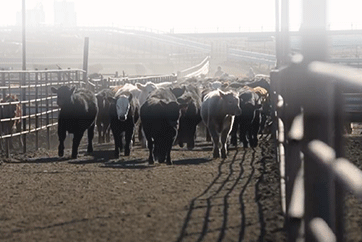Early BRD detection and treatment
equates to better outcomes
By Dr. Jacques Fuselier
Early detection of bovine respiratory disease (BRD) is critical. There is a greater chance of success with the first treatment, which means cattle will feel better quicker and get back to healthy behaviors sooner. You also have a chance to reduce lung damage and consolidation, which if they occur, can linger with the calf for the rest of the feeding period.
Because cattle are prey animals, early disease detection is challenging. They are wired to hide any signs of weakness or sickness, until the point when they cannot hide it anymore. When you start noticing signs of disease, the animal likely already is a couple days into the disease process.

Where do assessment and treatment of cattle fit in the overall order of operations? Involve your veterinarian in determining what time of day animals should be evaluated and treated. When labor is limited or operations are extra busy, it can be easy to postpone evaluating or treating sick animals. Waiting until tomorrow adds at least another 24 hours to disease progression that could have been avoided. The result? Treatment costs are greater. Treatment success and long-term outcome are negatively impacted.
Signs to look for
The typical but subtle signs that an animal is sick and/or needs to be further evaluated include lowered head or drooping ears, slowness to get to the bunk, and/or less movement than its counterparts. During feeding, you can more easily assess activity and monitor which animals may not be feeling as well. Different phases of the animal’s life impact how much movement typically is seen – with animals closer to the end of the feeding period spending more time lying down.
Operations should have protocols for assessing and treating sick animals. It is important to evaluate each animal and not work on assumptions. Watching the calf move and looking for signs of pain or inflammation in the joints are important. Is it a foot or leg problem, or is the issue higher up? Conduct an overall exam when the animal is in the chute and use a consistent evaluation pattern. For example, start by looking at the calf’s eyes and nose – do they have discharge, what does the discharge look like? Then move to the neck, down the front legs, and so forth.
As the disease progresses, it becomes evident what they are dealing with; it is more challenging to diagnose the problem in the early stages. Is it a gastrointestinal issue? Is it a respiratory issue? A joint issue? Using a consistent method to evaluate animals helps to institute the right treatment at the right time.
Should an NSAID be used
We typically do not know if BRD is caused by a virus or bacteria. If a virus is involved, a secondary bacterial infection often is on board. We talk a lot about the “bug” and “drug” when selecting a treatment protocol. However, the third component is the “host”, which in the case of BRD, is the calf, specifically their lungs.
Different bacteria release different toxins that cause the calf to release certain enzymes and proteins to try to fight the disease. This causes inflammation to make the environment hostile for the virus or bacteria. When inflammation occurs, it is non-specific, so damage occurs to all cells. In the case of BRD, the innocent bystanders are cells that make up the healthy lung tissue.
Fever and inflammatory response are important at the very beginning of the infection. They create an environment that is harmful to the virus or bacteria. In time, these responses can become damaging to healthy tissue.
Using a nonsteroidal anti-inflammatory drug (NSAID) – which is called an ancillary medication – with an antibiotic at first treatment can be helpful. An NSAID often is given to help reduce fever caused by BRD. A study evaluated three NSAIDS – flunixin, ketoprofen, and carprofen – each used in conjunction with an antibiotic (ceftiofur) in the treatment of naturally occurring BRD.1 All three NSAIDS reduced fever more than the antibiotic alone. However, flunixin and ketoprofen reduced it more quickly and to a greater extent than carprofen. Flunixin reduced the extent of lung consolidation more than the other two NSAIDS, and by significantly more than the antibiotic alone.
There are antibiotics that come in combination with a non-steroidal anti-inflammatory, so antibiotic and ancillary medication can be given in a single SubQ dose. Being able to use a product that is proven effective early in the process can help decrease disease and improve the comfort and welfare of the animal. A veterinarian can help determine which antibiotic is best based on the stage of the disease.
New technology for managing BRD
There are new tools being created and others becoming more widely available to help with BRD as it relates to disease prediction, detection, and confirmation. The SenseHub® Feedlot technology is used to monitor activity and body temperature to detect sick animals earlier and more accurately.
Getting calves pulled, evaluated and treated at the first signs of disease gives the best opportunity to minimize lung damage or consolidation due to the effects of the pathogen, and the calf’s overall response to the disease. Work with your veterinarian to determine the best evaluation methods and antibiotic and ancillary medications to help improve the calf’s treatment outcome and overall wellbeing.
Disclaimer
This product is not intended to diagnose, treat, cure, or prevent any disease in animals. For the diagnosis, treatment, cure, or prevention of diseases in animals, you should consult your veterinarian. The accuracy of the data collected and presented through this product is not intended to match that of medical devices or scientific measurement devices.
Resources
- Lockwood, P. W., Johnson, J. C., & Katz, T. L. (2003). Clinical efficacy of flunixin, carprofen and ketoprofen as adjuncts to the antibacterial treatment of bovine respiratory disease. The Veterinary record, 152(13), 392–394. https://doi.org/10.1136/vr.152.13.392
Find more content for your beef operation.
About the author

Dr. Jacques Fuselier, D.V.M., D.A.C.T., D.A.B.V.P.
Technical Services Manager,
Merck Animal Health
